Saiguhan Elancheran writes a detailed tactical analysis about the UEFA Champions League match that ended Borussia Monchengladbach 1-1 Manchester City.
After a scintillating display against Barcelona at the Etihad, the sky blues went to Borussia Park to face the Gladbach side who were lacking in confidence from their previous games. City were expected to come out with an easy victory, but what happened there was rather surprising. It was this fixture that kick started the run of Manuel Pellegrini’s men into the semi-finals of last season but this match was not half as lunatic as that game, as Man City showed no intent and lacked energy to kill the game.

Made using TacticalPad
Borussia Monchengladbach : (4-2-3-1/4-4-2) Sommer // Elvedi – Jantschke – Christensen – Wendt // Dahoud – Strobl // Traore(Hofmann 41’) – Stindl – Johnson // Raffael(Hahn 84’).
Manchester City : (3-4-3/3-2-4-1) Bravo // Otamendi – Stones – Kolarov // Silva – Fernandinho – Gundogan – De Bruyne // Navas – Aguero – Sterling(Sagna 68’).
To everyone’s surprise, Andre Schubert left Thorgan Hazard out for the night as Fabian Johnson replaced him. Though preferring a back three for the major part of the season, Schubert played a back four. Pep Guardiola started Jesus Navas ahead of the German international Sane and often relied Nolito. As Kompany was injured once again this season, he was left out the squad.
City attack and Gladbach defence :
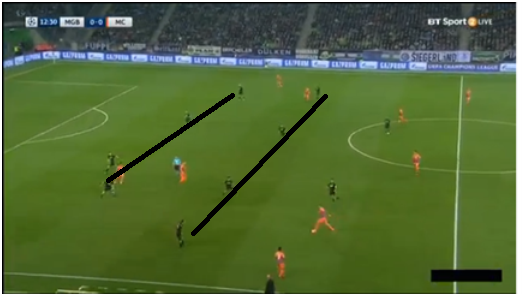
Right from the start of the game, Galdbach sat back and defended the game with two banks of four. This restricted City to sideways passing and forced City to be content with possession in the middle third with zero penetration.
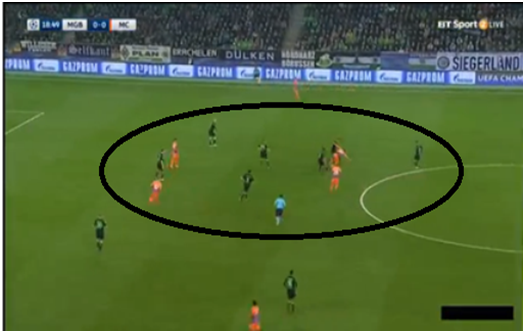
In this instance we can identify the compactness of the home side in the centre.
Gladbach’s farthest two – Stindl and Raffael – always dropped deep to provide numerical advantage in the midfield and as an effect City couldn’t play teasing balls forward. Dahoud proved to be an important player on the field for Gladbach as he won the midfield battle against Fernandinho. Though the latter played more number of passes and enjoyed a better success rate, it was Dahoud who restricted the Brazilian and did not allow to get past him in 1vs1 situations.
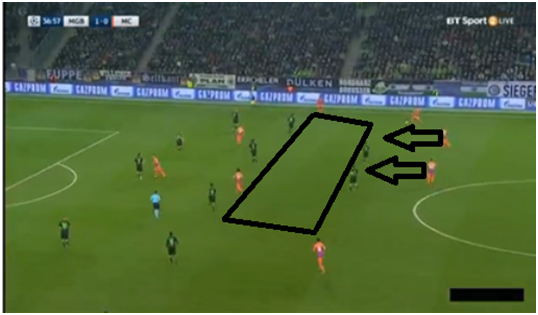
City were very slow in their build ups and failed to show intent as the game progressed. They lacked the ruthlessness which Pep always expects in his side. In the above scenario, City failed to occupy the spaces left the Galdbach players in midfield. The central midfielders Fernandinho and Gundogan should be occupying the space so that they can provide more passing options to the ball carrier from the right wing.

This was the only moment in the first half in which City had actually taken the ball beyond Gladbach defence. This proved to be a decisive chance as City scored through Silva. The ball carrier Sterling had actually switched flanks with Navas to play in a more conventional right winger’s role that he enjoys. His penetrating ball was collected by De Bruyne who played on to Silva who made the scores level. Here, the Gladbach’s defenders should have defended by marking the ball rather than marking the player.
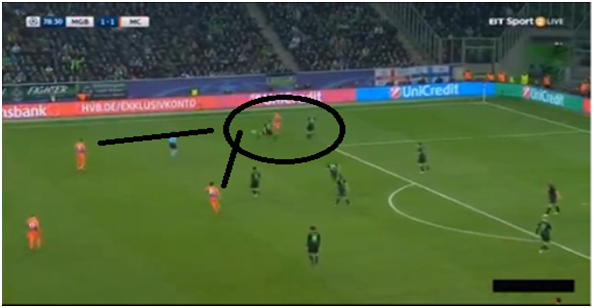
During the closing stages of the game, City showed zero intent of going forward. This is one such instance. Here the City winger is overloaded(2vs1) and he has no options to pass. The two players in the half space should get closer to the winger and provide him support as shown.
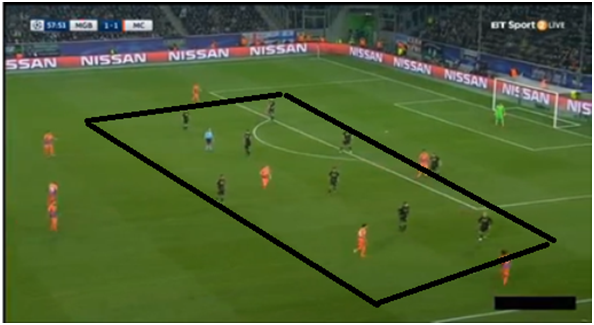
After the second yellow of Stindl that saw Galdbach reduce to 10 men, City tried to make use of the numerical advantage but Gladbach defended with low block which meant that they couldn’t penetrate. Here we can see all the Gladbach players in the City’s final third.
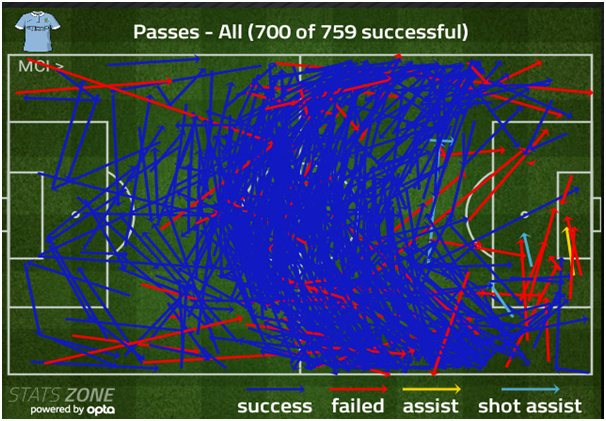
Photo Credit: www.fourfourtwo.com/statszone
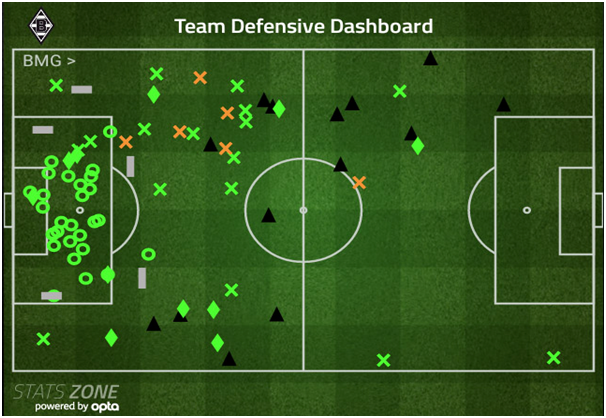
Photo Credit: www.fourfourtwo.com/
Here we can witness how City were reduced to sideways passing and Gladbach’s low block which did not allow City to play successful passes in the final third.
City’s fluid defence and Gladbach’s counter :
At the start of the game, City played a back 3 with Fernandinho playing infront of the defence. It was expected that Fernandinho would tuck in as the right back to play with a back 4 but City had other ideas.

All the city attacks started from the back but this tactic didn’t work out as Gladbach were very compact in the centre, the play was always in front or around the Gladbach defence as City couldn’t penetrate them.
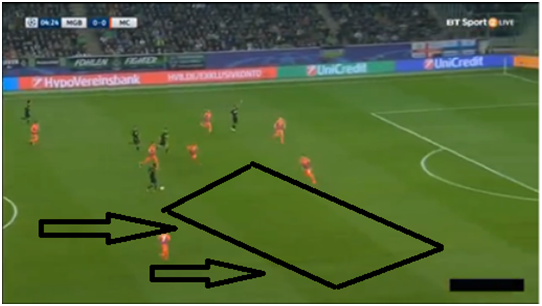
As Gladbach defended very deep they were unable to attack in numbers during the counters and breaks. They often failed to find an outlet whenever they regained possession of the ball. There was no single Gladbach player to occupy the space after a break in City’s attack.
Raffael scored the first goal of the game after 20 minutes through a quick counter that saw Stindl outrun Stones and as things didn’t work out as planned for City Guardiola switched to a back 4 surprisingly Jesus Navas playing as the Right back instead of Fernandinho. This was because Fernandinho had to restrict Dahoud from playing his natural game.
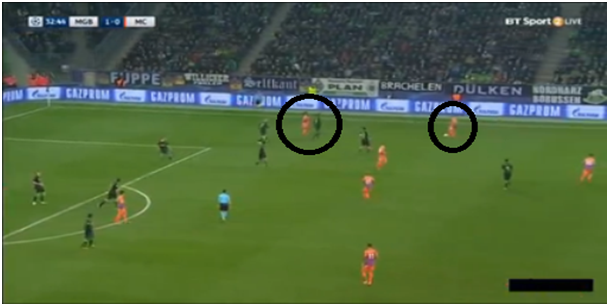
We can identify both Sterling and Navas in the same flank which aided 10 minutes later as Sterling created the chance for the goal from that half space.
After the half-time City again switched to a back 3. This time, Fernandinho played as the central defender between Stones and Otamendi. While Kolarov and Navas played in the midfield to create overloads in the wide areas along with Sterling and De Bruyne respectively. They again switched to a back 4 with Fernandinho playing infront of the back four. It differed in this manner – when City had the ball, Fernandinho dropped deeper to form back 3 and when City lost the ball, the back 4 took its shape to defend.
And after Fernandinho was given the marching orders, City played with a back four till the end of the game. City absolutely showed no intent and for the last ten minutes of the game kept the ball in their defensive half.
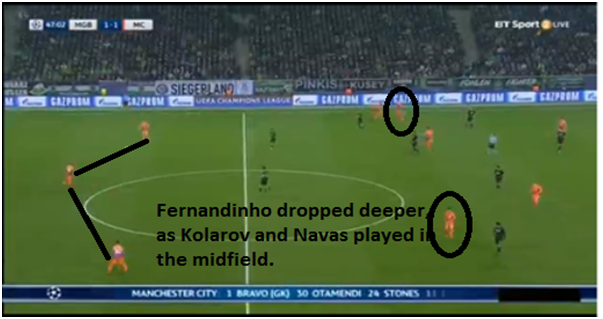
In the closing stages it was very questioning to see De Bruyne playing as a central midfielder along with Gundogan as Aguero was supported by Bacary Sagna upfront who was supposed to complete the back 4.
Aguero was seen no where as he was completely left isolated in the final third and City’s arsenal failed to supply him with the goods. He was man-marked by Christensen effectively as he shot only once on target.
Conclusion
One of the most striking stat from this match is that the most number of passes played was topped by the three City central defenders. With John Stones amassing 114 passes, along with Otamendi 110 and Kolarov 88, made sure that City crossed the line with a point that would see them through to the next round. Both the managers were quite content with the results as they ployed their teams to play with zero risk. The result sends Man City to the R16 who were below par as Gladbach booked a place in the Europa League.
Read all our Tactical Analyses here.

























































